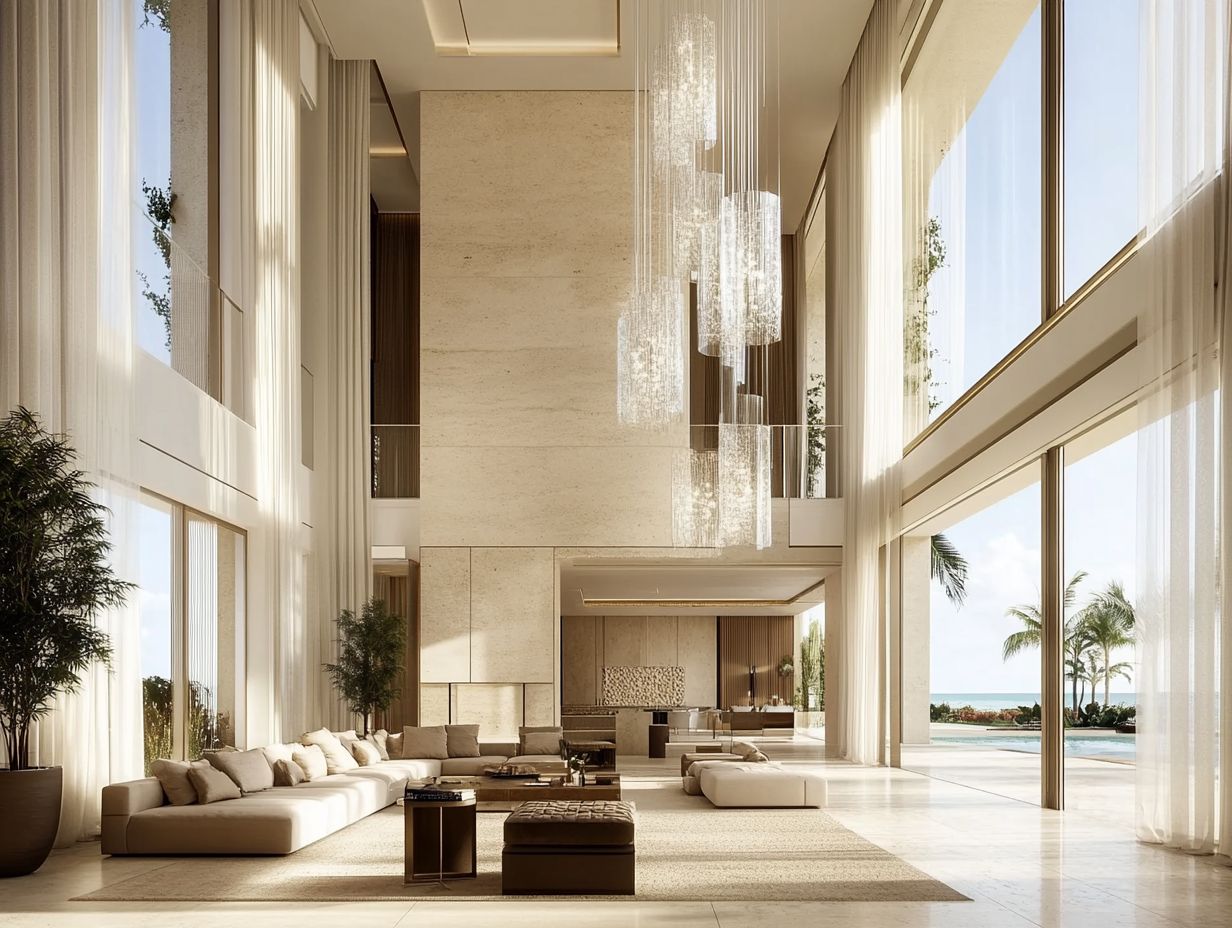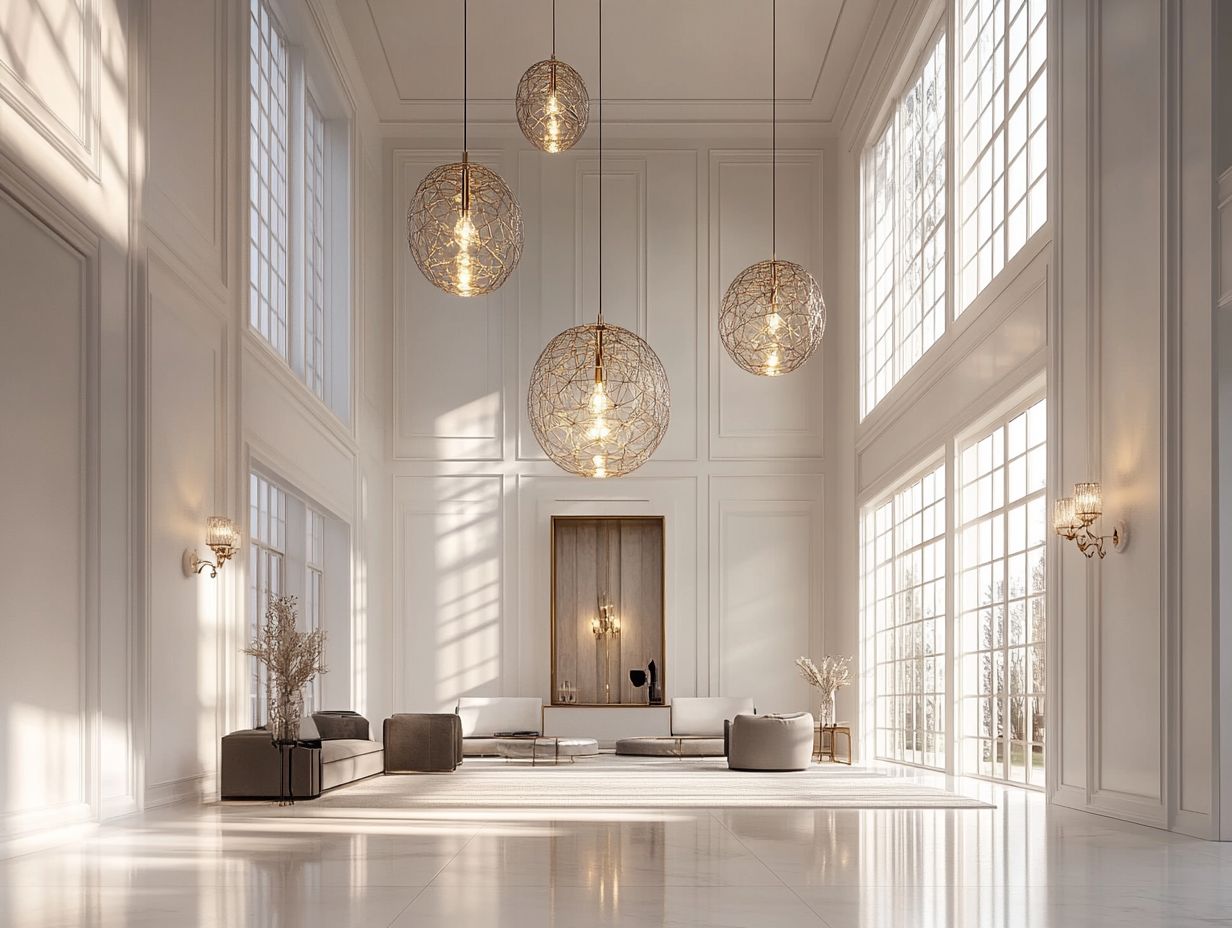The Best Lighting Solutions for High Ceilings
High ceilings have the remarkable ability to transform any space, imbuing it with an airy and open ambiance that elevates both its aesthetics and functionality. However, they also present unique challenges, especially in the realm of lighting.
This article delves into effective solutions specifically designed for elevated spaces, addressing fixture types, placement strategies, budget considerations, and maintenance tips. These insights will help ensure that your high ceilings are not only safe but also beautifully illuminated.
Explore how to optimize your lighting for that breathtaking vertical space!
Contents
- Key Takeaways:
- Understanding High Ceilings
- Challenges of Lighting High Ceilings
- Conclusion
- Lighting Solutions for High Ceilings
- Factors to Consider When Choosing Lighting
- Maintenance and Safety Considerations
- Frequently Asked Questions
- What are the main challenges when it comes to lighting high ceilings?
- What are some of the best lighting solutions for high ceilings?
- Can chandeliers be used as a lighting solution for high ceilings?
- Are there any energy-efficient lighting options for high ceilings?
- How can I determine the appropriate placement for lighting in a room with high ceilings?
- Are there any design considerations when choosing lighting solutions for high ceilings?
Key Takeaways:
- Understand the definition of a high ceiling and its impact on lighting choices.
- Consider factors such as budget, aesthetics, and functionality when choosing lighting solutions for high ceilings.
- Proper placement and installation techniques are crucial for effective and safe lighting in high ceiling spaces.

Understanding High Ceilings
Understanding high ceilings is essential for elevating both the aesthetic charm and functionality of your interior design. High ceilings can transform the ambiance of a space, infusing it with a sense of grandeur and openness that is both liberating and, at times, challenging.
They present unique opportunities for innovative lighting solutions. You can experiment with natural light, general lighting, and specific lighting for tasks to craft a visually stunning environment that aligns with your design vision.
By thoughtfully considering how to leverage the height of your rooms, you can enhance the atmosphere with creative lighting ideas and fixtures that truly make a statement.
What Constitutes a High Ceiling?
A high ceiling is generally regarded as any ceiling that goes beyond the standard height of eight feet commonly seen in residential spaces, often soaring to 10 feet or more, depending on architectural trends and personal design choices.
In your home, these elevated spaces amplify a sense of openness and enhance air circulation, contributing to a more comfortable living environment. In commercial settings, such as offices or retail stores, high ceilings create an expansive atmosphere that exudes grandeur and sophistication.
Take, for instance, the classic Victorian style, which often features intricate crown moldings and elaborate ceiling treatments. In contrast, modern minimalist designs emphasize clean lines and expansive glass features.
The advantages of high ceilings go beyond mere aesthetics; they facilitate an influx of natural light, making interiors feel more vibrant and inviting, which is a key principle of effective design.
Challenges of Lighting High Ceilings
Lighting high ceilings comes with distinct challenges that can hinder effective illumination and affect the overall ambiance of your space.
One of the key issues is finding the perfect balance between general lighting and specific lighting for tasks while ensuring every corner is well-lit. You want to avoid harsh shadows and overly bright spots that can disrupt the harmony of the room.
The height of the ceilings complicates the installation of various fixtures like recessed lights, pendant lights, and wall sconces. This makes it crucial to consider innovative solutions tailored to address these unique circumstances.
Common Issues and Concerns

When lighting high ceilings, you’ll encounter several common issues and concerns that can significantly impact the effectiveness and efficiency of your lighting plan.
Poor light distribution can lead to darker areas, diminishing the overall ambiance of your space. The challenge of frequently changing bulbs in hard-to-reach fixtures not only adds to your maintenance costs but also introduces safety hazards if not handled properly.
It’s crucial to consider energy efficiency as well, because inefficient lighting can inflate your utility bills over time. Factors like beam angle and fixture placement play vital roles in how well light penetrates your environment, ensuring every corner is adequately illuminated while steering clear of unwanted glare.
Create a balanced and inviting atmosphere that will impress everyone! By tackling these concerns, you can enhance the beauty and functionality of your space.
Conclusion
In summary, effectively lighting high ceilings involves understanding their unique characteristics and challenges. With the right strategies, you can transform your space into a stunning showcase of light and design.
Don’t miss out on these fantastic lighting solutions! Explore specific products or resources tailored for high ceiling lighting to elevate your interior design today.
Lighting Solutions for High Ceilings
Exploring effective lighting solutions for high ceilings is important for creating spaces that are both functional and visually stunning. You have a wealth of options at your disposal, each adaptable to your unique needs and preferences.
By integrating a variety of lighting fixtures—like recessed lights, elegant pendant fixtures, stylish wall sconces, and ceiling fans—you can elevate the overall ambiance of the room while tackling specific lighting challenges.
With careful placement and the right mix of lighting types, such as ambient (general) and accent (highlighting specific features) lighting, you can craft an inviting and aesthetically pleasing environment that truly reflects your style.
Types of Lighting Fixtures to Consider
When crafting a lighting plan for high ceilings, it’s essential to explore various lighting fixtures that enhance the space while maintaining both functionality and visual appeal.
Recessed lighting is a versatile choice, blending into the ceiling and providing ample illumination without overwhelming the area.
Pendant lights hang gracefully and create a captivating focal point that directs the eye downward, making them ideal for breakfast bars or dining areas.
Ceiling fans improve air circulation and incorporate unique light fixtures that highlight the room’s height and grandeur.
Don’t overlook the chandelier; it brings elegance and dramatic flair, serving as a statement piece that transforms the atmosphere while complementing the design principles of balance and harmony in high-ceilinged spaces.
Placement and Installation Techniques
Strategically placing lighting fixtures and employing effective installation techniques are essential for successful lighting design in high ceilings.
When considering the arrangement of fixtures, height is critical; they should be installed at a level that optimally illuminates the space without casting harsh shadows or creating overwhelming brightness. The beam angle is also key—narrower beams focus light on specific areas, while wider angles spread illumination more evenly across the room.
Don’t overlook how natural light interacts with your design; understanding how daylight enters the space can significantly inform the positioning and intensity of your artificial lights.
For installation, using adjustable mounts can enhance flexibility, allowing for future adjustments while ensuring that safety standards are met to minimize potential hazards and simplify maintenance.
Factors to Consider When Choosing Lighting

When selecting lighting for high ceilings, several key factors can profoundly impact both effectiveness and overall satisfaction with the design.
Budget, Aesthetics, and Functionality
Balancing your budget, aesthetics, and functionality is important when selecting lighting solutions for high ceilings. The right fixtures should seamlessly enhance both the space and your overall design vision.
Achieving this balance may seem challenging, but it’s feasible when you consider how each element interacts. For instance, using pendant lights at varying lengths can create visual interest while providing ample illumination. Recessed lighting offers a sleek appearance and accentuates architectural features without overwhelming the room.
To keep your budget in check, explore cost-effective options like LED bulbs or vintage-style fixtures that can elevate your design without compromising quality. Incorporating dimmers allows you to adjust ambiance effortlessly and is also energy-efficient.
By thoughtfully merging style with practicality, you can create a space that is as beautiful as it is functional.
Maintenance and Safety Considerations
To ensure safety and functionality in lighting high ceilings, give thoughtful attention to maintenance practices and safety protocols.
This approach ensures that your environment remains well-lit, captivating, and secure.
Ready to elevate your high-ceiling space? Start planning your lighting today!
Tips for Keeping High Ceiling Lighting Safe and Functional
Keeping high-ceiling lighting safe and functional requires specific safety tips and maintenance practices. These practices are essential for long-term effectiveness and security.
Conduct regular inspections of your lighting fixtures to identify any wear and tear that could compromise safety.
Opting for LED bulbs is a smart move; they enhance energy efficiency while minimizing heat output, thereby reducing the risk of overheating.
Ensure that you have accessible ladders or scaffolding on hand for maintenance tasks. This allows you to perform necessary upkeep safely.
Incorporating safety measures, such as securing loose wiring and using fixtures designed for high altitudes, can further enhance both functionality and safety.
Take proactive steps today to ensure your space is safe and well-lit!
Frequently Asked Questions

What are the main challenges when it comes to lighting high ceilings?
The biggest challenge is getting enough brightness without causing glare or shadows. High ceilings need more powerful lights to fully illuminate the space.
What are some of the best lighting solutions for high ceilings?
Pendant lights, track lighting, and recessed lighting are all great options for high ceilings. They provide sufficient lighting while also adding visual interest to the space.
Can chandeliers be used as a lighting solution for high ceilings?
Yes, chandeliers can definitely be used for high ceilings. Choose a chandelier with a longer chain or cord to hang it at the appropriate height and ensure it is properly secured to the ceiling.
Are there any energy-efficient lighting options for high ceilings?
Yes, LED lights are a fantastic energy-efficient option for high ceilings. They have a longer lifespan and use less energy than traditional incandescent bulbs, making them a cost-effective choice.
How can I determine the appropriate placement for lighting in a room with high ceilings?
Generally, lighting should be placed at least 7 feet above the ground in a room with high ceilings to ensure proper illumination. The best placement will also depend on the specific layout and purpose of the room. Consulting a professional can help determine the ideal placement for your space.
Are there any design considerations when choosing lighting solutions for high ceilings?
Yes, it is important to consider the overall design aesthetic of the space when choosing lighting for high ceilings. For example, if the space has a modern and minimalistic design, a large and ornate chandelier may not fit well. Also, consider the scale and proportion of the lighting fixture in relation to the size of the room and the height of the ceiling.





